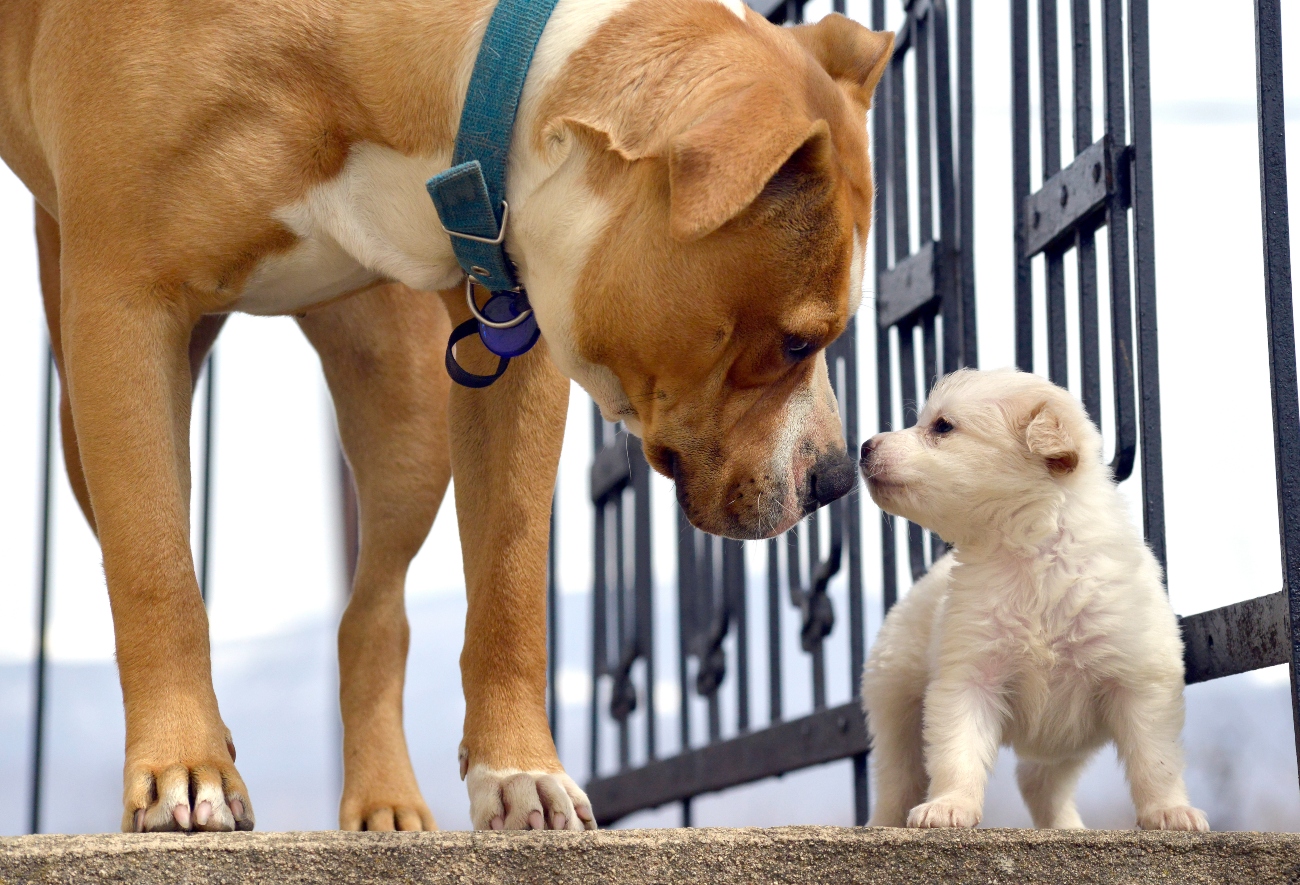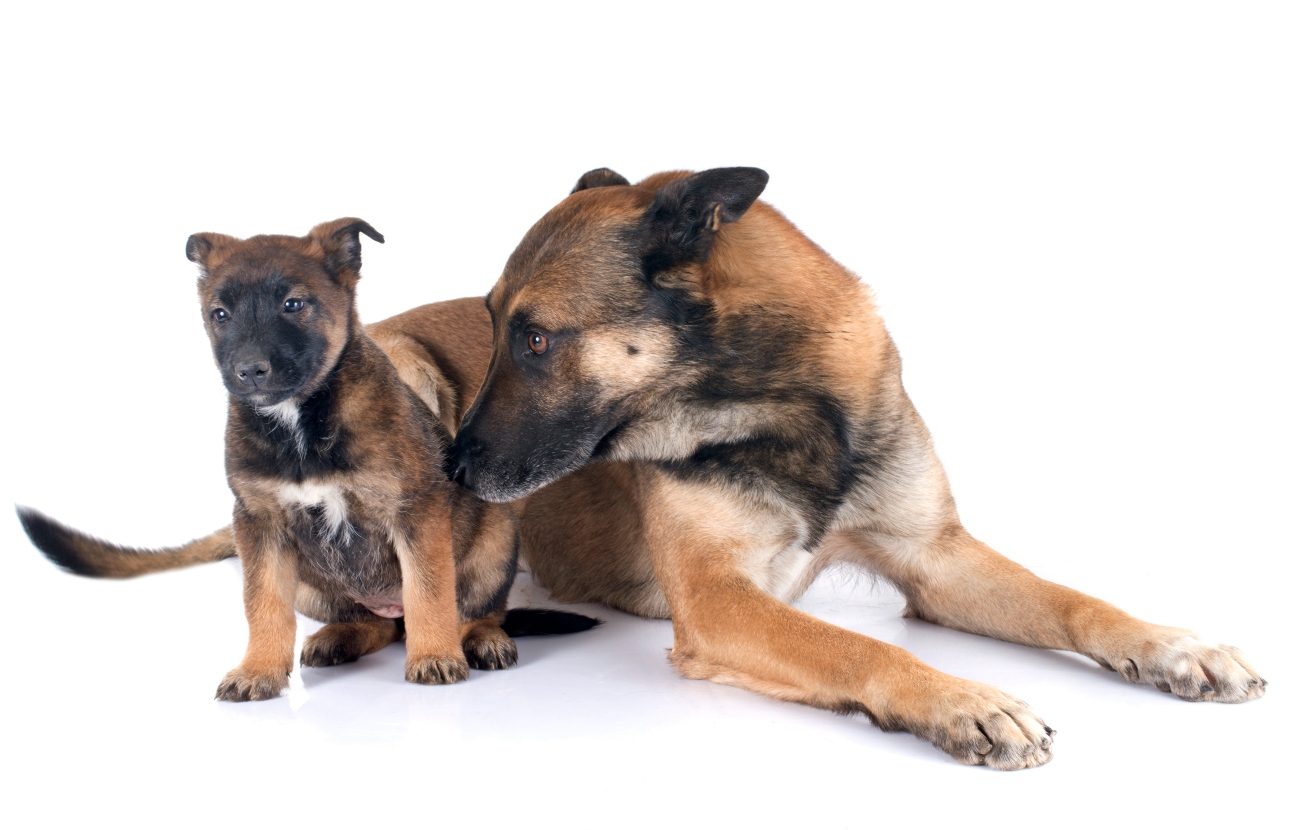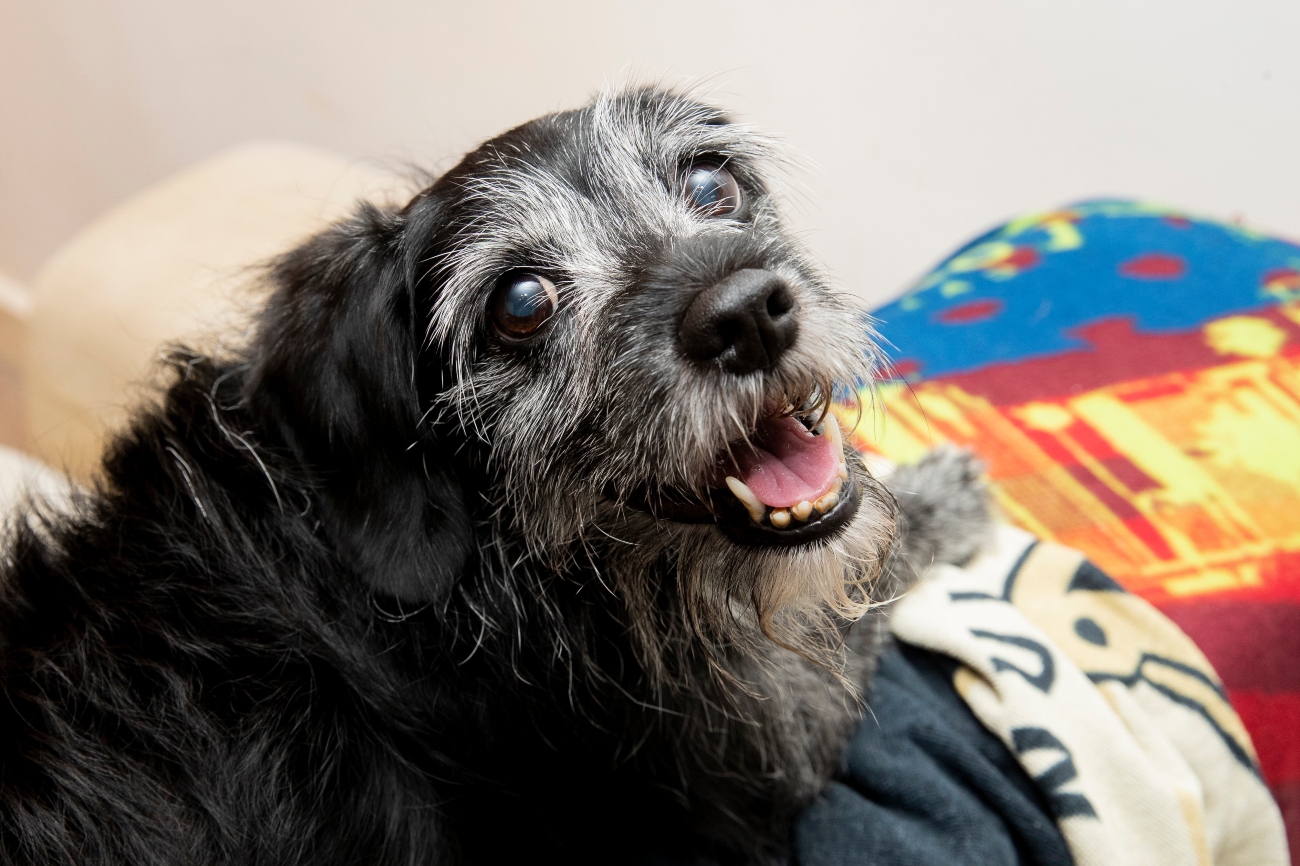
Getting a puppy with an older dog
26th August, 2022
Before you bring your puppy home to meet your older dog, you need to plan how to make the introduction as stress free as possible. This Petwise guide shows you how.
Getting a new puppy is a super-exciting time for everyone. You’ve found the ideal pooch and can’t wait to bring it home, but what about your older dog?
Will they like the new addition to the family?
It’s natural for canines to protect their home turf, so preparing for their meeting is vital to make it a smooth transition for every person and pup involved.
Here, we’ll run through what to consider before getting a puppy, how to introduce them to your existing pet, and the possible risk areas to watch out for.
Before we jump in, make sure both your new and old canine family members are covered in case of an emergency.
Come to a specialist like Petwise to find the right pet insurance for senior dogs. Our sister company, Purely Pets, can help cover their younger counterparts, protecting them against the unexpected through every stage of their life.
What to consider before you get a puppy with an older dog
You want to get a new puppy, but is it fair on your older hound? You wonder whether they can handle the change and stress, or if the new addition will adapt to its surroundings.
Before taking the leap, ask yourself the following questions to make the right decision:
- Does your older dog like other animals?
- Does your senior pet like young and playful puppies?
- Is your elderly animal in good physical health?
- Do you have time and money to look after an old dog and a demanding puppy?
If you answered yes to all the above, then it’s time to welcome an adorable puppy into your home. As long as your older pooch is physically fit and enjoys younger company, they should get along well.
Make sure you have enough time and money to care for them both. Expect to provide the following for your pair of pups:
- Specific food for young and old dietary requirements.
- Two comfortable beds and separate crates to ensure they have their own space.
- Plenty of toys to share.
- Pet insurance for senior dogs and your new puppy.
- Up-to-date vaccinations for both pets.
How to make it fair for both dogs
You’ll want both dogs to live happily at home. There are a few ways you can make the transition fairer on both animals.
- Give yourself enough time to provide separate exercise and training for both dogs.
- Continue to enjoy one-on-one outings with your senior pet when you can.
- Pick lower energy breeds, especially if your older dog isn’t overly active.
- Make sure the puppy never irritates your older pet.
- Create separate spaces so your senior dog can rest away from the puppy.
Sometimes, introducing a new puppy into your home doesn’t go as smoothly as planned, and your resident canine may feel stressed or anxious. Make sure your older dog has pet insurance for senior pets so you don’t hesitate in taking them to the vets if needed.
If you find you have trouble helping your dogs get along, your vet can recommend what steps to take next to keep them both happy and healthy.
How long does it take for a senior dog to accept a puppy?

There’s no single answer to this question, and it depends on a variety of factors, including your setup and both your older and younger dog’s disposition.
Usually, the crazier the puppy is, the longer it takes a senior dog to get used to them. Aim for a laid-back youngster to accompany your mellow older pup.
Some especially calm breeds include:
- Saint Bernard
- Shih Tzu
- Cavalier King Charles spaniel
- Whippet
- Tibetan spaniel
- Corgi
- Border terrier
At the other end of the spectrum, the most high-energy puppies that your older dog might find too hyper to live with include:
- German shepherd
- Huskies
- Border collies and other herding dogs
- Jack Russell terrier
Try to match your older dog’s energy to your new puppy to help them get along better.
You can help them get off to a good start by adopting your younger dog when they’re 8-12 weeks old. They still sleep often at this age and aren’t so hyperactive. Once they get to 3-4 months, their energy increases and this may pester your senior pup.
Preparation before you bring your puppy home
Before we share our top tips on introducing your two dogs, you need to prepare your home for the puppy’s arrival. Put away all your older dog’s favourite toys to avoid them becoming territorial and aggressive.
Make sure both animals have a separate space if they need to get away from each other and that you have food dishes for them both – at mealtimes, dogs can become especially possessive, which can lead to fights.
7 steps to introducing a puppy to an older dog
Remember, your senior pet is naturally going to protect its territory and your puppy may feel unsure about their new surroundings. Make sure you have pet insurance for senior dogs in place in case of any injuries caused through fighting in these early stages.
Fortunately, there are a few steps you can take to make it easier on both dogs and help them get along from the get-go.
1. Meet in a neutral area
The very first time your puppy and senior dog meet should be on neutral ground. This can be a neighbour or friend’s garden, a training centre, or anywhere else that’s quiet. This way, your older pet won’t feel threatened or protective of their home and can start to make friends with your puppy.
If you don’t have a neutral spot for their first meeting, take them to a park or outdoor area where you visit often with your dog. They’ll be used to seeing other new pups here and will be more willing to play with your new addition.
2. Use a fence
Your dog can sense when you feel anxious or wary, however small. Pair this with being kept on the lead and they may become fearfully aggressive. To keep your older pooch and your puppy as relaxed as possible when they meet one-on-one for the first time, don’t keep them on the lead.
In an open setting they may have got along well, but to keep them safe, let them meet face-to-face with a barrier, like a chain-link fence or netting. This can help the ‘new dog’ excitement wear off before they finally meet nose-to-nose.
This step is especially important if there’s a big size difference between your dogs. However docile and friendly your senior dog is, they can accidentally injure the puppy when they get over-excited.
3. Go for a parallel walk
Another great way to help your pups get to know each other in a relaxed and friendly setting is by going for a ‘walkie’. Every dog loves this activity, and it gives them room to move and reduce the chance of aggression.
A different person should hold each dog’s lead and use a treat to keep their animal’s eyes on them while staying out of nose-sniffing range. Walk together side-by-side for 10 minutes before allowing the pups to get any closer.
4. Find sniffing opportunities
When both dogs seem interested in each other and happy to meet, let them off the lead or remove the barrier between them. Keep them in an open space to reduce tension and let the sniffing commence. Expect them to show proper canine greeting etiquette by sniffing each other’s rear ends!
Don’t let this first greeting go on for much longer than 10 minutes. You don’t want either dog to tire and become frustrated with the other. Keep calling them away now and again and give them treats to maintain a happy atmosphere and prevent tension from forming.
5. Check for positive signs
If your dogs want to play with each other, that’s an excellent sign. Just like humans display certain body language when they’re happy or sad, canines do the same. A classic dog sign of wanting to have fun with another pup is the ‘play bow’, where you see the tail end go up and the head go down.
Another friendly signal is a doggy yawn, which means they’re showing other pups they pose no threat. Licking the other dog’s face and rolling on their back is another positive signal, which the puppy may display to tell the older pup to cut him some slack.
Only let this first play session last a few minutes and end it on a good note. Stay alert for any signs of negativity. Dogs bark, growl, and whine while playing but these sounds can also be a sign of feeling threatened.
Watch their body language to tell whether they’re having fun or becoming aggressive.
6. Meet in your garden
Once both your older dog and puppy get along on neutral ground, it’s time to move them closer to home. Before letting them indoors, give them the chance to meet in your garden. If the space is enclosed, let them have some fun off the lead.
If you have more than one older dog at home, let them out one at a time so the new addition doesn’t feel too overwhelmed.
7. Bring them into your home
When you think your dogs are ready, it’s finally the moment to welcome your puppy inside your home. It’s best to do this out of sight of your other pets. Keeping your older dog in the garden is a good idea while you bring the new furry family member through the front door.
When you’re indoors and settled, your senior pup can enter and find the puppy already inside. As they already know each other, this should cause the least problems.
And remember, if you’re in the garden, make sure it’s dog-friendly and secure – dog thefts are on the rise.
Top 3 risk areas during the introduction
The top three aspects of a dog’s environment that can cause the most conflict are their food, bed, and toys. Take extra care when it comes to these areas while introducing the puppy into your older dog’s setting.
- Bed: Firstly, make sure both pups have a separate space to sleep and enjoy some downtime. This means different beds and crates for each and even a gate between them if they’ll be left alone during the day.
- Food: Most canines become extra possessive when their food gets put in front of them. Invest in a new set of bowls for your puppy and give them their meals in separate areas, at least to begin with. While pet insurance for senior dogs is important for looking after your older companion’s health, so is their diet. They likely have food specially for older dogs, while the puppy should have a nutritious mix for younger pooches.
- Toys: No doubt your senior pup has some favourite toys by now. Get a new set for your puppy and keep your older dog’s games in its crate.
What not to do during the introduction
You’ve seen the best ways to introduce your older companion with your new puppy, but what shouldn’t you do? The following highlights what you should never do when your dogs meet for the first time:
- Do not let the senior dog bully the youngster.
- Do not let the two dogs get into a fight.
- Do not hold the puppy while you introduce them – this can make the older dog jealous and more likely to become aggressive.
- Do not force them to play or be close to each other.
- Do not let them share the same bed or crate.
Health problems in older dogs that could make it difficult

Before you consider getting a new puppy, factor in any health concerns of your older pet. A dog is considered senior around the age of 7, so once yours reaches this milestone, it’s a good idea to visit the vet for a check-up.
This is also the age when you should be thinking about getting specialist pet insurance for senior dogs, like the cover we offer at Petwise. With no upper age limit, your older pet can enjoy the healthcare it deserves when it needs it.
The following health issues may make it difficult for your senior companion to get along with a boisterous young pup, and vice versa.
Hearing and/or vision loss:
There are varying degrees of blindness and deafness in ageing dogs, and the older they get, the more prone they are to cataracts. When an animal can’t see or hear as well as it once could, it might not know the puppy is approaching and get frightened more easily.
Joint issues:
According to the Kennel Club, osteoarthritis and arthritis become more prevalent as a dog gets older, and they may suffer pain as a result. A jumping and playful puppy bounding all over them is likely the last thing they want when they need to rest.
Dementia and/or cognitive dysfunction:
Like humans, dogs can develop these conditions as they age. If a canine is already getting lost in familiar surroundings or anxious with people and animals it used to enjoy spending time with, it’s not a good idea to get a puppy. A new addition may add to the confusion and make your senior pet more uncomfortable.
These conditions along with other age-related problems may make your senior dog more aggressive than it once was. With the right pet insurance for senior dogs in place, you can take them to the vet whenever necessary and not worry about a sudden bill in an emergency.
Health problems in puppies that could make it difficult
While you might not expect your new puppy to come with a host of health issues, it’s important to be aware of certain problems that may arise and how to avoid them. Puppies are small and their immune systems are still forming.
To give your pet the best start in life, they should have had all their vaccines, which makes them much less likely to get:
- Parvovirus (Parvo)
- Distemper
- Kennel Cough
- Adenovirus
- Leptospirosis (this isn’t a standard vaccine, so ask your vet if your pup needs it)
In addition to pet insurance for senior dogs, make sure your youngster is covered, too. Some insurance companies can cover your puppy from as young as 8 weeks of age, so getting this sorted as soon as possible helps you protect them early on.
How can a young pup feeling ill affect your older dog? If your puppy has diarrhoea or vomiting, you need to get it to the vet as soon as possible to diagnose the cause.
If it has a parasite or intestinal virus, it may pass it along to your senior pet, which could make them seriously ill.
Although you might want to adopt a puppy with existing health issues and give it a nurturing and loving home, it’s not ideal with an older dog. Your senior pup needs more care as they age, so a young and healthy puppy shouldn’t take away any of the love and attention they need from you.
Look after your ageing dog with pet insurance
A puppy can make a wonderful friend to older dogs and keep them sprightly in their later years. But it can also cause problems if you don’t introduce them correctly.
At Petwise, we understand what a beloved family member your older pup is and why you want them to make the most of their golden years.
Pet insurance for senior dogs protects them and makes sure they get the healthcare they need, when they need it most.
Covering your senior dog with a Petwise policy gives you the following benefits*:
- Access to our 24/7 video consultation service
- Dental cover
- No upper age limit to joining
- Contribution for senior food
- Farewell cover
Are you looking for pet insurance for senior dogs to give your old companion the best in later life?
Contact the team at Petwise today.
*Policy exclusions and limitations apply